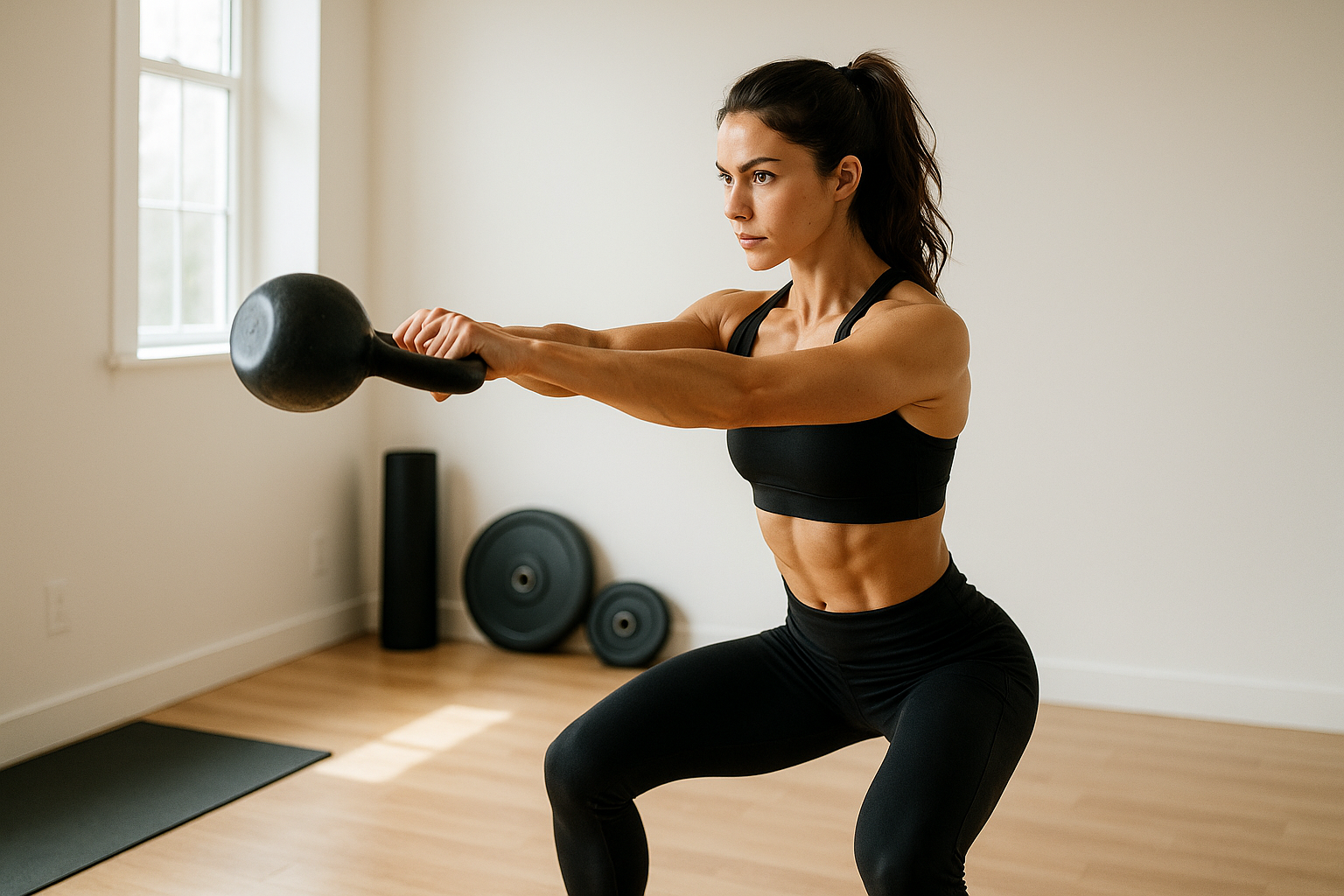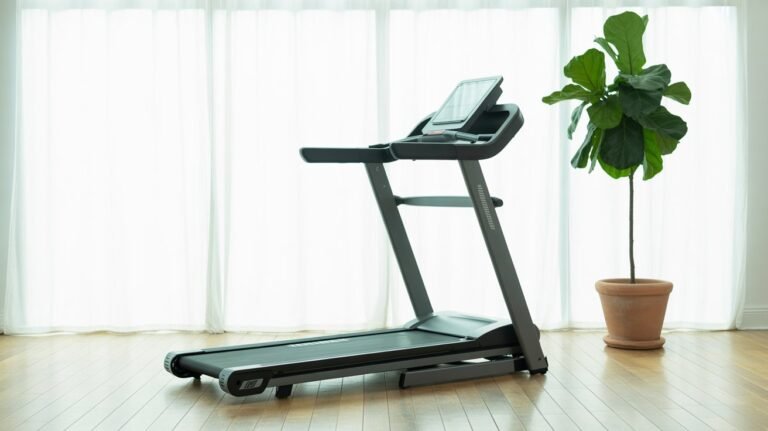Kettlebells are one of the most versatile pieces of equipment you can have at home — and if you’re a beginner, they might seem a little intimidating. But don’t worry: with the right guidance, kettlebell workouts can help you burn fat, build strength, and boost endurance faster than traditional exercises, all in a fun and dynamic way.
Unlike ordinary weight training, kettlebell moves engage multiple muscle groups at once, improve your balance, and elevate your heart rate, giving you a full-body workout in a fraction of the time.
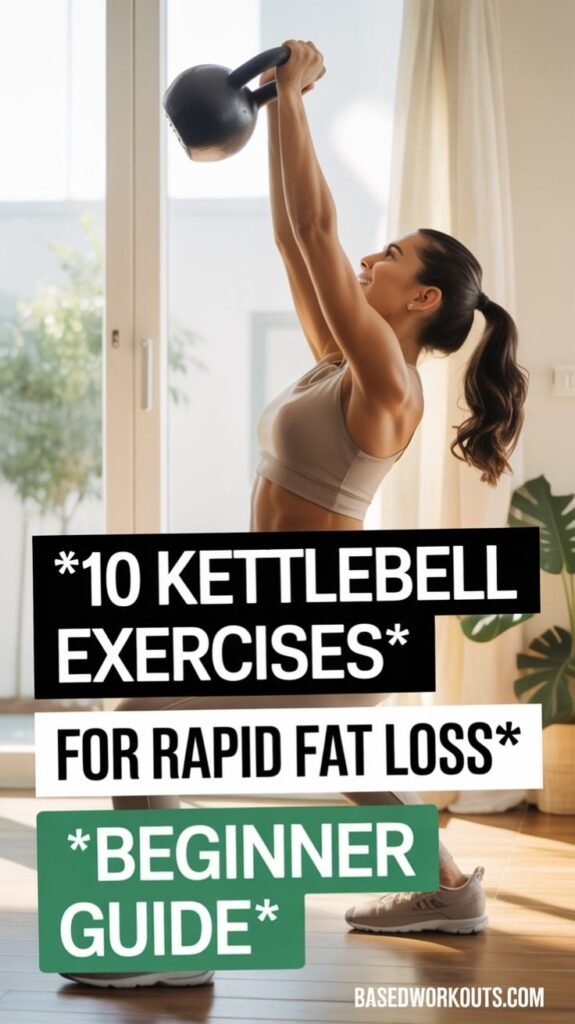
In this guide, we’ll walk you through beginner-friendly kettlebell exercises that are safe, effective, and easy to learn.
From foundational swings and squats to moves that target your core and upper body, each exercise is designed to help you get stronger, leaner, and more confident in your fitness journey.
By the end, you’ll have everything you need to start your kettlebell routine at home — no guesswork, no intimidation, just results.
This article on Kettlebell Workouts for Beginners may include affiliate links to recommended kettlebells and workout gear. If you buy through these links, I may earn a small commission at no extra cost to you. I only suggest equipment I genuinely believe will help you burn fat, build strength, and improve endurance.
- What kettlebells are
- Why they’re great for home & gym workouts
- Benefits: fat-burning, muscle building, functional strength
2. Benefits of Kettlebell Training
Kettlebell training has surged in popularity because it combines strength, endurance, and cardiovascular conditioning in one efficient workout.
Unlike traditional dumbbells or machines, kettlebells allow for dynamic, full-body movements that engage multiple muscle groups simultaneously.
Here’s why adding kettlebells to your fitness routine can be highly effective:
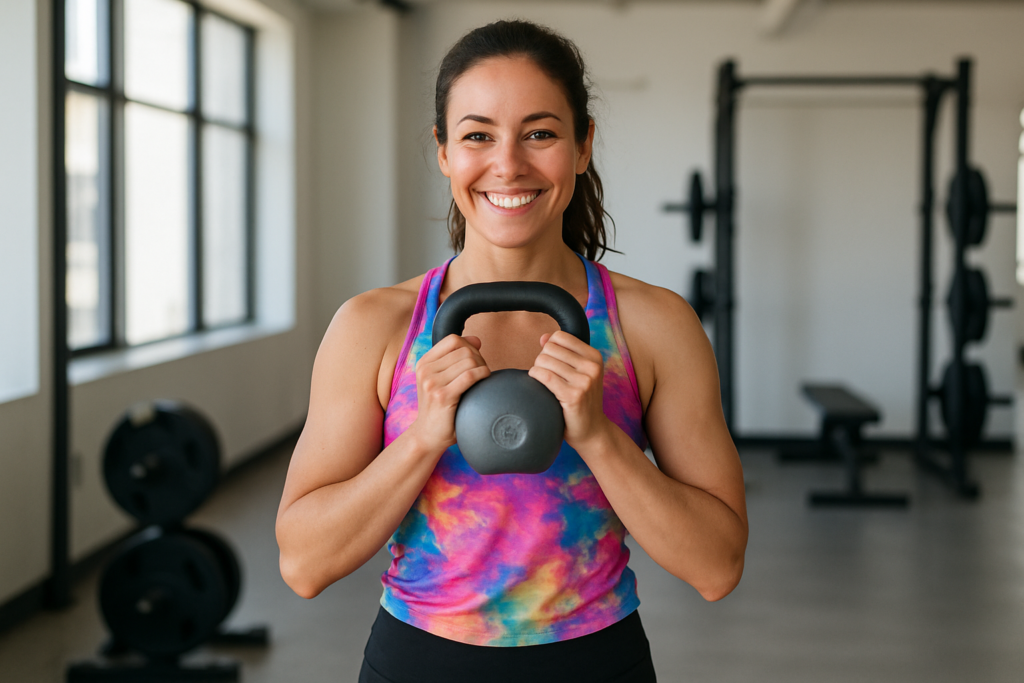
1. Builds Full-Body Strength
Kettlebell exercises often involve compound movements, meaning they work multiple muscles at once.
For example, a kettlebell swing engages the glutes, hamstrings, core, back, and shoulders, while a Turkish get-up targets nearly every muscle in the body.
This functional strength translates to improved performance in daily activities and other workouts.
2. Improves Cardiovascular Fitness
Kettlebell workouts combine strength and cardio in a single session.
High-repetition swings, snatches, and cleans elevate your heart rate while building muscle, making them excellent for burning calories and improving heart health.
Many people experience a higher metabolic boost after kettlebell sessions compared to traditional weight training.
3. Enhances Core Stability and Balance
Almost all kettlebell movements require core engagement for stability, helping strengthen abdominal muscles, obliques, and lower back.
Exercises like the windmill or kettlebell lunge press improve balance, coordination, and functional core strength, reducing the risk of injury in daily life and sports.
4. Increases Power and Explosiveness
Dynamic movements like swings, cleans, and snatches train fast-twitch muscle fibers, which are crucial for explosive power.
Athletes, martial artists, and fitness enthusiasts use kettlebells to improve speed, agility, and athletic performance.
5. Burns Fat and Builds Muscle Simultaneously
Kettlebell workouts are high-intensity and metabolic, meaning they burn calories efficiently while stimulating muscle growth.
A single session can elevate heart rate, increase post-workout calorie burn, and promote lean muscle development, making it an excellent tool for fat loss and body composition improvement.
6. Enhances Flexibility and Mobility
Kettlebell training often incorporates dynamic stretches and full-range movements, which improve joint mobility, flexibility, and functional movement patterns.
Exercises like the Turkish get-up and windmill enhance shoulder, hip, and thoracic spine mobility, contributing to better overall movement quality.
7. Time-Efficient Workouts
Because kettlebell exercises combine strength, cardio, and flexibility, they provide a full-body workout in less time compared to traditional gym routines.
This makes them ideal for busy individuals looking to maximize results in shorter sessions.
8. Improves Grip Strength
The unique handle and swing mechanics of kettlebells challenge your forearms and grip, which can improve performance in other lifts, sports, and daily activities that require hand and forearm strength.
Final Thoughts
Kettlebell training is a versatile and effective tool that builds strength, burns fat, improves cardiovascular fitness, enhances core stability, and develops power and mobility. Whether you’re a beginner or an advanced athlete, kettlebells can transform your workouts, making them more functional, challenging, and efficient.
3. Essential Kettlebell Exercises for Beginners
Kettlebells are versatile tools that allow you to build strength, endurance, and mobility in one workout.
For beginners, it’s important to focus on foundational movements to develop proper form, prevent injury, and maximize results.
Here’s a guide to the most effective kettlebell exercises for beginners:
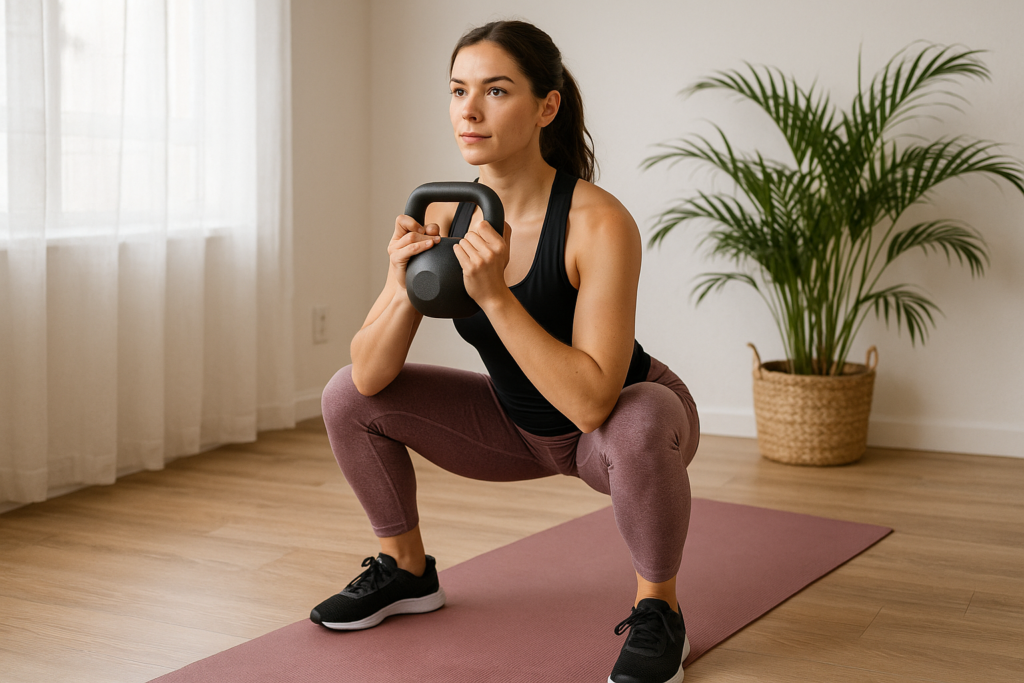
1. Kettlebell Deadlift
Purpose: Builds posterior chain strength (hamstrings, glutes, lower back) and teaches hip hinge mechanics.
How to Do It:
- Stand with feet shoulder-width apart and a kettlebell on the floor between your feet.
- Hinge at your hips, keep your back straight, and grab the kettlebell handle.
- Drive through your heels and stand upright, squeezing your glutes at the top.
- Slowly lower the kettlebell back to the floor with control.
Tips: Focus on form over weight. Keep shoulders down and back flat.
2. Kettlebell Swing
Purpose: Improves power, endurance, and burns fat while strengthening glutes, hamstrings, and core.
How to Do It:
- Stand with feet slightly wider than shoulder-width and hold the kettlebell with both hands.
- Hinge at the hips and swing the kettlebell between your legs.
- Thrust your hips forward explosively to swing the kettlebell up to chest height.
- Let the kettlebell swing back down and repeat.
Tips: Avoid using your arms to lift; the power comes from the hips and glutes.
3. Goblet Squat
Purpose: Strengthens quads, glutes, hamstrings, and core while teaching proper squat mechanics.
How to Do It:
- Hold a kettlebell close to your chest with both hands.
- Stand with feet shoulder-width apart and toes slightly out.
- Lower into a squat, keeping your chest up and knees tracking over toes.
- Push through your heels to stand back up.
Tips: Keep your core engaged and avoid letting your knees collapse inward.
4. Kettlebell Press (Overhead Press)
Purpose: Builds shoulder, triceps, and core strength while improving stability.
How to Do It:
- Hold a kettlebell at shoulder height with your palm facing forward.
- Press the kettlebell overhead until your arm is fully extended.
- Lower it back down slowly with control.
Tips: Keep your core tight to prevent leaning back. Start with lighter weight to master form.
5. Kettlebell Row
Purpose: Strengthens upper back, lats, and biceps while improving posture.
How to Do It:
- Place a kettlebell on the floor in front of you.
- Hinge at your hips and slightly bend your knees, keeping your back flat.
- Grab the kettlebell and row it towards your torso, squeezing your shoulder blades.
- Lower slowly and repeat.
Tips: Avoid rounding your back. Focus on controlled movement and engaging your back muscles.
6. Kettlebell Farmer’s Carry
Purpose: Improves grip strength, core stability, and overall functional strength.
How to Do It:
- Hold a kettlebell in each hand at your sides.
- Stand tall with shoulders back and core engaged.
- Walk forward for a set distance or time, keeping your posture upright.
Tips: Avoid leaning or slouching; maintain a strong, stable core throughout.
7. Kettlebell Lunge
Purpose: Strengthens legs, glutes, and core while improving balance and coordination.
How to Do It:
- Hold a kettlebell in one hand at your side or both hands at chest level.
- Step forward into a lunge, lowering your back knee toward the floor.
- Push through the front heel to return to standing.
- Alternate legs and repeat.
Tips: Keep your front knee aligned with your toes and avoid letting it go past your foot.
Beginner Workout Example
Perform 2–3 rounds of:
- Kettlebell Deadlift – 10 reps
- Kettlebell Swing – 15 reps
- Goblet Squat – 12 reps
- Kettlebell Press – 8 reps per arm
- Kettlebell Row – 10 reps per arm
- Farmer’s Carry – 30 seconds
- Kettlebell Lunge – 10 reps per leg
Rest 60–90 seconds between rounds. Start with lighter weights and focus on form and controlled movement.
Final Tips for Beginners
Warm up before and stretch after your session to prevent injury and improve mobility.
Start with light to moderate weights and gradually increase as your strength improves.
Focus on form and technique rather than speed or heavy lifting.
Incorporate kettlebell workouts 2–3 times per week alongside cardio or other strength training.
4. Beginner Kettlebell Workout Plan (20 Minutes)
Kettlebells are perfect for full-body conditioning, fat burning, and building strength in a short amount of time.
This 20-minute workout is designed for beginners to get a complete session without feeling overwhelmed, focusing on form, balance, and controlled movement.
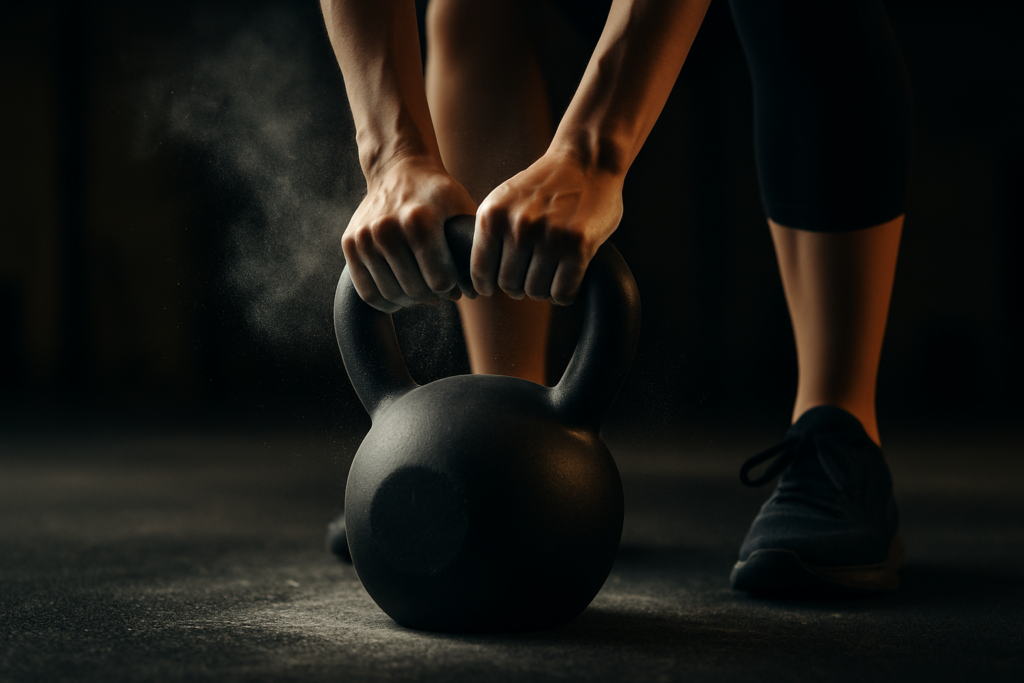
Workout Structure
- Duration: 20 minutes
- Equipment: 1–2 kettlebells (light to moderate weight for beginners)
- Format: Circuit style, 40 seconds per exercise, 20 seconds rest, repeat circuit 2–3 times
Warm-Up (3–5 Minutes)
Before starting, warm up to prevent injury and prepare your muscles:
- Arm circles – 30 seconds
- Bodyweight squats – 10 reps
- Hip hinges – 10 reps
- Shoulder rolls – 30 seconds
- March in place or light jogging – 1 minute
Workout Circuit
1. Kettlebell Deadlift
- Time: 40 seconds
- Rest: 20 seconds
- Focus: Posterior chain (glutes, hamstrings, lower back) and proper hip hinge.
2. Goblet Squat
- Time: 40 seconds
- Rest: 20 seconds
- Focus: Quads, glutes, core stability. Keep chest up and knees over toes.
3. Kettlebell Swing
- Time: 40 seconds
- Rest: 20 seconds
- Focus: Glutes, hamstrings, core, and cardiovascular conditioning. Power comes from the hips.
4. Kettlebell Press (Overhead Press)
- Time: 40 seconds (20 seconds per arm if using one kettlebell)
- Rest: 20 seconds
- Focus: Shoulders, triceps, and core stability. Maintain upright posture.
5. Kettlebell Row
- Time: 40 seconds (alternate arms if using one kettlebell)
- Rest: 20 seconds
- Focus: Upper back, lats, biceps. Control the movement and squeeze shoulder blades.
6. Kettlebell Lunge
- Time: 40 seconds (20 seconds per leg)
- Rest: 20 seconds
- Focus: Glutes, quads, core, and balance. Step forward and push through the heel.
7. Farmer’s Carry
- Time: 40 seconds
- Rest: 20 seconds
- Focus: Grip strength, core stability, posture. Walk with kettlebells at your sides, keeping your core tight.
Cool-Down (2–3 Minutes)
Finish with stretches to prevent soreness and improve flexibility:
- Hamstring stretch – 30 seconds per leg
- Quad stretch – 30 seconds per leg
- Shoulder stretch – 30 seconds per arm
- Hip flexor stretch – 30 seconds per side
- Deep breathing – 30 seconds to relax
Tips for Beginners
- Start light: Prioritize form over heavy weight.
- Control your movements: Avoid swinging or jerking the kettlebell unnecessarily.
- Consistency matters: Perform this workout 2–3 times per week for optimal results.
- Hydrate and rest: Keep water nearby and rest adequately between circuits.
Expected Results
- Improved full-body strength and muscle tone
- Enhanced core stability and posture
- Increased cardiovascular endurance and calorie burn
- Better movement coordination and balance
5. How to Choose the Right Kettlebell Weight
Selecting the right kettlebell weight is one of the most important decisions when starting a kettlebell training program.
The right weight ensures you can perform exercises safely, maintain proper form, and get the most benefit from your workouts.
Choosing a kettlebell that is too heavy can increase the risk of injury and compromise your form, while a weight that is too light won’t provide enough resistance to stimulate strength, endurance, or muscle growth.
Here’s an in-depth guide to help you make the right choice for your fitness level, goals, and exercises.
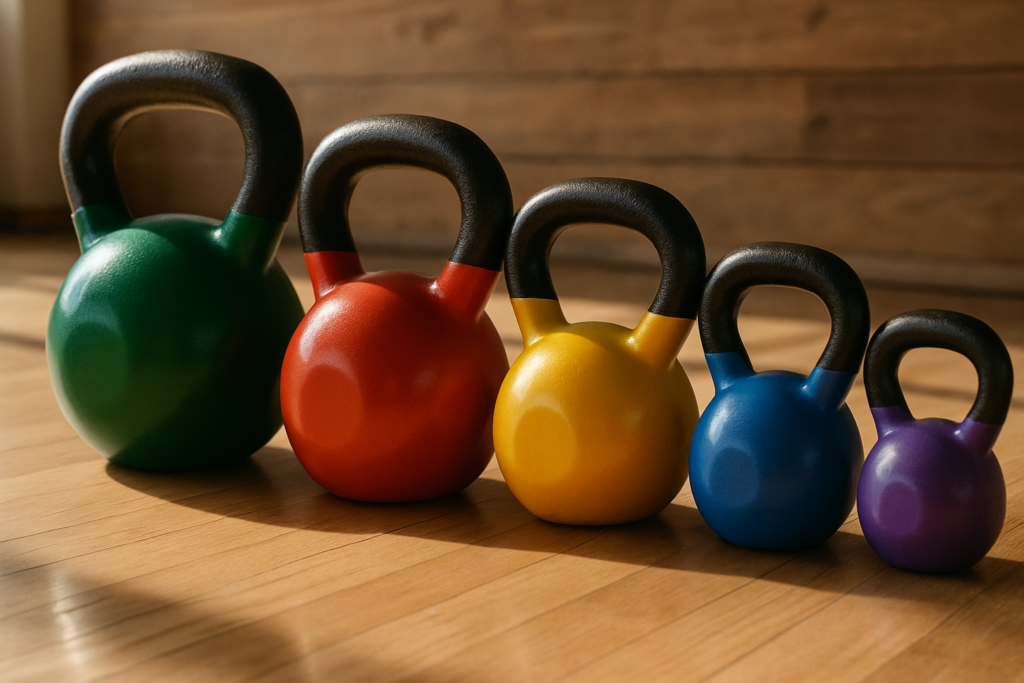
1. Consider Your Fitness Level
Beginners:
- If you are new to strength training or kettlebells, it’s better to start lighter.
- Men can usually begin with kettlebells ranging from 12–16 kg (26–35 lbs).
- Women often start with kettlebells ranging from 8–12 kg (18–26 lbs).
- Starting lighter allows you to learn proper form and control before progressing to heavier weights.
Intermediate/Advanced:
- For those with prior strength training experience, a slightly heavier kettlebell can be used.
- Men may use 16–24 kg (35–53 lbs) for general exercises.
- Women may use 12–16 kg (26–35 lbs) depending on the movement and personal strength.
- Advanced users performing swings, snatches, or cleans may use heavier kettlebells, but always maintain form.
2. Consider the Type of Exercise
Different kettlebell exercises require different weight levels:
Lower-body exercises (squats, lunges, swings):
- Larger muscle groups can handle heavier weights.
- Men: 16–24 kg (35–53 lbs)
- Women: 12–16 kg (26–35 lbs)
Upper-body exercises (presses, rows, carries):
- Smaller muscle groups cannot handle as much weight.
- Men: 12–16 kg (26–35 lbs)
- Women: 8–12 kg (18–26 lbs)
Full-body or dynamic exercises (snatches, Turkish get-ups):
- Weight should challenge you but still allow smooth, controlled movement.
- Men: 12–20 kg (26–44 lbs)
- Women: 8–16 kg (18–35 lbs)
3. Factor in Your Goals
Strength and muscle building:
- Choose a kettlebell that allows you to perform 6–12 reps with good form, leaving the last 1–2 reps challenging.
Endurance and fat loss:
- Lighter kettlebells with higher repetitions (15–20+) can increase calorie burn and cardiovascular benefits.
Power and explosiveness:
- Use a kettlebell heavy enough to generate force, especially for swings, cleans, or snatches, but not so heavy that it sacrifices technique.
4. Test Your Weight Before Buying
If possible, try different kettlebell weights in a gym or store:
- Perform a few reps of your intended exercises (e.g., swings or goblet squats).
- Pay attention to whether you can maintain proper posture and technique.
- Check if the weight is challenging but controllable—you should feel fatigue by the end of the set but not risk form breakdown.
5. Consider Progression
Kettlebell training is most effective when you gradually increase the weight over time:
- Start with a manageable weight to learn technique.
- As your strength improves, move to the next weight increment.
- Most kettlebells come in 2–4 kg (5–10 lb) increments, which is ideal for progression.
6. Practical Tips for Beginners
- Start light and focus on form: Good technique reduces the risk of injury and builds a strong foundation.
- Use different weights for different exercises: You don’t need one kettlebell for all movements. For example, you may use a heavier kettlebell for swings and a lighter one for presses.
- Prioritize safety: If you feel strain in joints or your back, the weight is too heavy.
- Consider adjustable kettlebells: These allow you to progress without buying multiple kettlebells.
7. Summary Table of Recommended Beginner Kettlebell Weights
| Exercise Type | Women (kg/lb) | Men (kg/lb) |
|---|---|---|
| Swings / Deadlifts / Squats | 12–16 kg / 26–35 lb | 16–24 kg / 35–53 lb |
| Presses / Rows / Upper Body | 8–12 kg / 18–26 lb | 12–16 kg / 26–35 lb |
| Full-body / Dynamic Movements | 8–16 kg / 18–35 lb | 12–20 kg / 26–44 lb |
Final Thoughts
Choosing the right kettlebell weight is about balancing challenge and control. Start lighter to master form, reduce injury risk, and build confidence.
Over time, progressively increase your weight to continue building strength, endurance, and power.
Remember, the “right” kettlebell is not the heaviest one you can lift, but the one that allows you to perform safe, effective, and controlled movements while still challenging your muscles.
6. Safety Tips for Kettlebell Training
Kettlebells are highly effective tools for building strength, endurance, and overall fitness, but improper use can lead to injuries, especially in the wrists, shoulders, back, and knees.
Safety should always be a priority, particularly for beginners.
The following tips will help you maximize results while minimizing risk
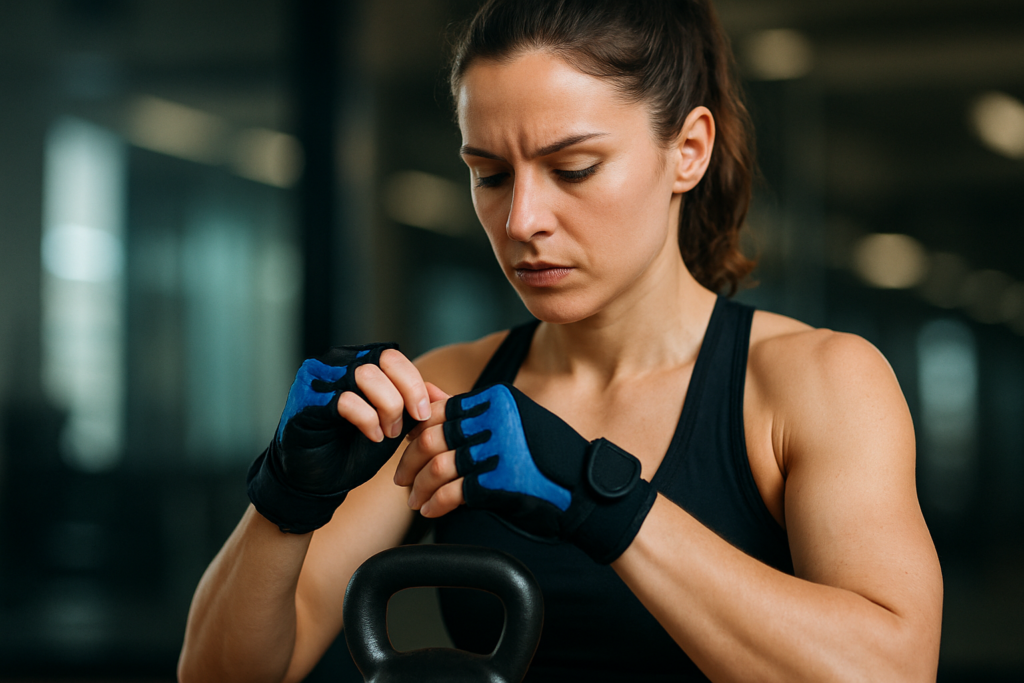
1. Start with Proper Instruction
Before jumping into kettlebell training:
- Learn proper technique: Attend a class, watch certified tutorials, or work with a trainer to understand safe movement patterns.
- Focus on form over weight: Correct posture ensures muscles are engaged properly and joints are protected.
- Master foundational moves like swings, goblet squats, presses, and deadlifts before progressing to advanced exercises.
2. Choose the Right Weight
- Selecting a kettlebell that is too heavy increases the risk of muscle strain and joint injury.
- Beginners should use a moderate weight that allows proper form for 10–15 controlled repetitions.
- Remember, it’s better to start light and progress gradually than to lift too heavy and compromise safety.
3. Warm Up Before Training
A proper warm-up is critical for preventing injuries and improving performance.
- Perform dynamic stretches targeting shoulders, hips, hamstrings, and wrists.
- Include bodyweight movements such as squats, lunges, and arm circles.
- Warm up for at least 5–10 minutes before starting your kettlebell routine.
4. Maintain Proper Form
Good form is essential for safety:
- Keep your core engaged to protect your lower back.
- Avoid rounding your back during swings, deadlifts, and rows.
- Keep knees aligned with toes during squats and lunges.
- Control the kettlebell throughout the movement—never let it swing uncontrollably.
5. Use a Safe Training Space
- Ensure you have enough room around you to swing the kettlebell safely.
- Train on a non-slip surface to prevent falls.
- Avoid cluttered areas or hardwood floors that could lead to slippage or dropped weight accidents.
6. Avoid Overtraining
- Kettlebell exercises are highly demanding, especially swings and dynamic moves.
- Limit sessions to 2–4 times per week for beginners, allowing recovery in between.
- Listen to your body: Muscle soreness is normal, but sharp pain is a sign to stop and rest.
7. Protect Your Wrists and Grip
- Hold the kettlebell handle firmly but avoid locking your wrists.
- Use chalk or gloves if your hands sweat to prevent slipping.
- Strengthen grip with farmer’s carries and holds to reduce strain during dynamic exercises.
8. Focus on Controlled Movements
- Avoid swinging the kettlebell too fast or using momentum to lift it.
- Perform smooth, controlled reps, especially for presses, rows, and get-ups.
- Controlled movements maximize muscle activation and reduce the risk of injury.
9. Cool Down and Stretch
After training:
- Stretch the hamstrings, glutes, shoulders, and back to prevent stiffness.
- Use foam rolling to relieve tight muscles.
- Hydrate to support muscle recovery and performance.
10. Listen to Your Body
- Pain is a warning sign. Stop immediately if you feel discomfort in joints, lower back, or shoulders.
- Adjust weight, reps, or exercise variations as needed.
- Gradually increase intensity over time rather than rushing into heavier weights or advanced moves.
Final Thoughts
Kettlebells are powerful tools for strength, endurance, and fat loss, but safety is essential to long-term success.
By focusing on proper instruction, controlled movements, appropriate weight, and recovery, you can train effectively without risking injury.
A mindful approach ensures that kettlebell workouts remain efficient, challenging, and safe, whether you’re a beginner or progressing to advanced training.
7. Recommended Kettlebells
Choosing the right kettlebell is just as important as choosing the right weight. With so many options on the market, it can be overwhelming to decide which brand, style, or material will suit your needs.
The ideal kettlebell should provide durability, comfort, and versatility, while supporting safe and effective training. Below is a comprehensive guide to help you make the right choice.
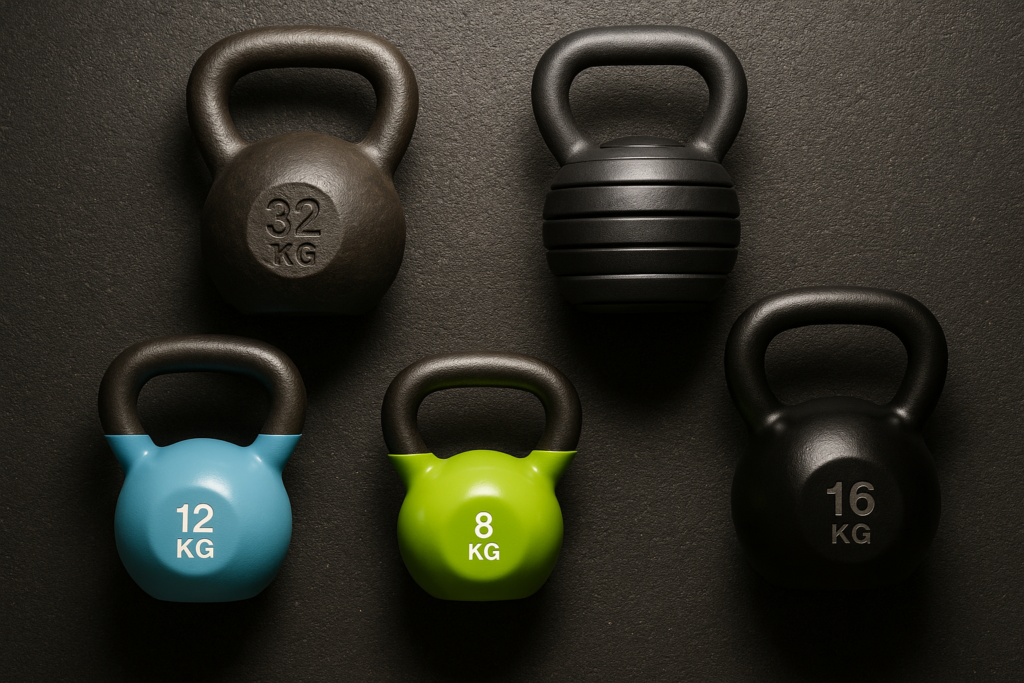
- Iron Kettlebell on Amazon – Durable, classic design, perfect for home workouts
- Adjustable Kettlebell – Save space with multiple weights in one
- Vinyl-Coated Kettlebell – Floor-friendly and comfortable grip
1. Factors to Consider When Choosing a Kettlebell
Before exploring specific brands or models, consider these key factors:
Weight Range
- Beginners should start with a moderate weight:
- Women: 8–12 kg (18–26 lbs)
- Men: 12–16 kg (26–35 lbs)
- For intermediate or advanced users, a heavier kettlebell may be appropriate, depending on your goals and exercise type.
Material
- Cast Iron: Traditional and highly durable, perfect for home gyms.
- Steel: Usually smoother and allows for precise manufacturing; ideal for competition-style training.
- Coated (Vinyl or Rubber): Protects floors and reduces noise, but may slightly alter grip.
Handle Design
- Look for a wide, smooth handle that allows a firm grip for both single and double-handed exercises.
- Handles should have enough clearance for two hands on heavier kettlebells.
- Smooth handles reduce friction but ensure they’re not too slippery.
Shape
- Traditional round kettlebells are versatile and widely used for swings, presses, and squats.
- Competition kettlebells have a uniform size regardless of weight, which is ideal for advanced training or Olympic-style movements.
Durability and Quality
- Invest in a kettlebell that can withstand repeated drops and heavy use.
- Avoid cheap, poorly cast kettlebells that can chip, crack, or have uneven weight distribution.
2. Recommended Kettlebell Brands
a. Rogue Fitness Kettlebells
- Pros: Extremely durable, excellent handle finish, wide weight range.
- Ideal for: Home gyms and serious athletes.
- Why it stands out: Rogue kettlebells are known for precision, consistent weight, and high-quality cast iron.
b. Onnit Kettlebells
- Pros: Smooth, powder-coated finish, ergonomic handles, and unique designs.
- Ideal for: Functional training and aesthetic appeal.
- Why it stands out: Onnit kettlebells balance durability with comfort, making them beginner-friendly and versatile.
c. Kettlebell Kings
- Pros: Competition-grade steel kettlebells and color-coded weight options.
- Ideal for: Serious lifters and kettlebell enthusiasts.
- Why it stands out: Kettlebell Kings offers professional-grade equipment with uniform size and ergonomic design.
d. CAP Barbell Coated Kettlebells
- Pros: Rubber-coated, protects floors, budget-friendly.
- Ideal for: Beginners and home use.
- Why it stands out: These kettlebells are affordable, safe, and durable, making them a great entry-level option.
e. Amazon Basics Kettlebells
- Pros: Wide range of weights, affordable, cast iron construction.
- Ideal for: Beginners on a budget or casual users.
- Why it stands out: While not as refined as premium brands, Amazon Basics kettlebells are a convenient and reliable option for most beginners.
3. Adjustable Kettlebells
For those with limited space or who want progressive weight options, adjustable kettlebells are an excellent choice:
- Bowflex SelectTech 840 Kettlebell: Adjustable from 8–20 kg (18–44 lbs).
- Yes4All Adjustable Kettlebell: Allows for adding/removing plates to customize weight.
Advantages:
- One piece of equipment replaces multiple kettlebells.
- Cost-effective for home gyms.
- Ideal for gradual strength progression.
Disadvantages:
- Slightly bulkier than fixed kettlebells.
- Not ideal for high-intensity swinging exercises in some models.
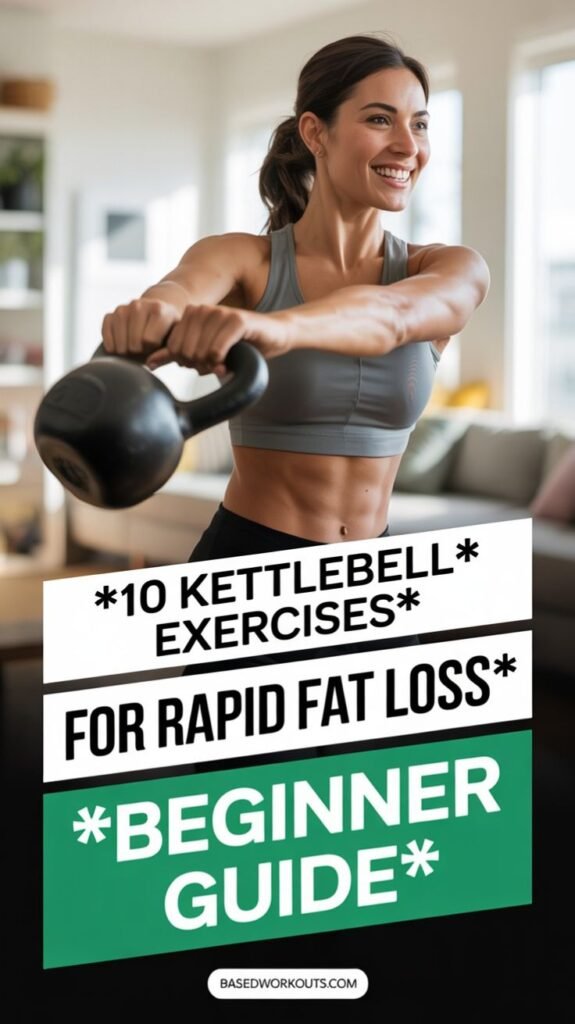
4. Tips for Choosing the Best Kettlebell for You
- Match your weight to your goals and strength level: Lighter for technique and endurance, heavier for strength and power.
- Prioritize a comfortable handle: Ensure your grip is secure and suitable for both single and double-handed exercises.
- Consider the type of training: Cast iron for general training, competition steel for advanced lifts, coated for home use.
- Start with one or two kettlebells: Begin with a manageable weight and expand your collection as strength improves.
- Check customer reviews: Look for consistent feedback on durability, handle comfort, and quality control.
Final Thoughts
Choosing the right kettlebell is crucial for safety, performance, and long-term training success. Investing in a high-quality kettlebell ensures you can perform a wide variety of exercises effectively, protect your joints, and progress safely.
Whether you’re a beginner or advanced lifter, selecting the right brand, weight, and material will make your kettlebell training more enjoyable, efficient, and effective.
8. Conclusion
Kettlebell training is an incredibly versatile and effective way to build strength, improve endurance, enhance mobility, and burn fat. From beginners learning the fundamentals to advanced athletes seeking high-intensity workouts, kettlebells offer something for everyone.
Throughout this guide, we’ve covered:
- Why kettlebell training matters, including full-body benefits and functional strength improvements.
- Essential exercises for beginners, such as swings, goblet squats, presses, rows, and lunges.
- How to structure a 20-minute beginner workout, providing a balanced, efficient routine.
- How to choose the right kettlebell weight and recommended brands, ensuring safe and effective training.
- Safety tips, highlighting proper form, warm-ups, and progression strategies to prevent injury.
The key takeaway is that success with kettlebells comes from consistency, proper technique, and gradual progression. Starting with the right weight, mastering fundamental movements, and following a structured routine will allow you to maximize results safely and efficiently.
Remember: kettlebell training is not just about lifting heavier weights—it’s about controlled movements, proper posture, and challenging yourself while respecting your body’s limits. Over time, you’ll notice improvements in muscle tone, strength, endurance, and overall fitness.
By investing in quality equipment, practicing safe techniques, and following a structured plan, kettlebells can become a long-term cornerstone of your fitness journey, whether your goals are fat loss, muscle growth, or full-body conditioning.
Frequently Asked Questions (FAQ)
1. How heavy should a beginner kettlebell be?
For beginners, weight depends on your gender and exercise type:
- Women: 8–12 kg (18–26 lbs)
- Men: 12–16 kg (26–35 lbs)
Start lighter to master proper form, then gradually increase weight as you build strength.
2. How often should I train with kettlebells?
- Beginners: 2–3 times per week, allowing at least a day of rest between sessions.
- Intermediate/Advanced: 3–4 times per week, depending on intensity and other training.
Rest and recovery are important to prevent overuse injuries.
3. Can kettlebells help with fat loss?
Yes. Kettlebell workouts combine strength training and cardiovascular conditioning, which can increase calorie burn, boost metabolism, and support fat loss when paired with a balanced diet.
4. What are the safest kettlebell exercises for beginners?
- Kettlebell deadlifts
- Goblet squats
- Kettlebell swings
- Overhead presses
- Rows
These exercises engage large muscle groups, are easier to learn, and help build foundational strength.
5. Do I need multiple kettlebell weights?
Not initially. Beginners can start with one or two kettlebells:
- One lighter weight for upper-body exercises.
- One heavier weight for lower-body exercises and swings.
As you progress, you may add more weights for variety and challenge.
6. Can I do kettlebell training at home?
Absolutely. Kettlebells are space-efficient and ideal for home workouts. Ensure you have enough room to swing the kettlebell safely and use a non-slip surface or mat to protect floors.
7. Are adjustable kettlebells a good option?
Yes. Adjustable kettlebells save space and allow progressive weight increases. They are especially useful for home gyms or limited space, but some models may feel bulkier than traditional fixed kettlebells.
8. How do I prevent injuries while training with kettlebells?
- Warm up before each session.
- Start with a weight you can control.
- Focus on proper form, not heavy lifting.
- Gradually increase intensity and weight over time.
- Keep your core engaged and maintain good posture throughout each exercise.
9. Can women safely train with kettlebells?
Yes. Kettlebell training is suitable for all fitness levels and genders. Women often benefit from improved strength, endurance, and overall conditioning, and can safely use the same exercises as men with appropriate weights.
10. How long until I see results?
Results vary depending on consistency, diet, and training intensity. Most beginners notice:
- Improved strength and endurance within 2–4 weeks
- Visible changes in muscle tone within 4–8 weeks
- Long-term benefits such as fat loss and improved mobility after 8–12 weeks of consistent training
